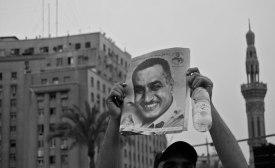tahrir square

CPD University Fellow Laurie Brand considers the evolution of Middle Eastern nation branding with a focus on Algeria and Egypt.
Last November, senior government officials held a ceremony in Egypt’s Tahrir Square, unveiling a monument to the revolution’s martyrs. The monument was simple, though its significance was not. It consisted of a stone pedestal on a circular base in the center of Tahrir Square. A military band played. At a brief unveiling ceremony that morning, Egypt’s interim Prime Minister Hazem el-Beblawi said it was meant to honor “the martyrs of the January 25 and June 30 revolutions.”
On January 25, 2011, the day Egypt's revolution began, Jehane Noujaim had a tough call to make. She could stay in Cairo to see if anything might come from the rumors about big protests planned for that day. Or, she could chase some high-level Egyptian officials to Davos, Switzerland.
“The casual visitor to the square in early 2013 might even wonder if SpongeBob has become, like the ubiquitous Che Guevara shirts or the spooky Guy Fawkes masks made popular by the film V for Vendetta, a bizarre transnational pop culture symbol of resistance,” Malsin added. SpongeBob’s images have even become as ever-present as images of revolutionaries who were killed during the uprising, particularly in Cairo, the newspaper reported.







